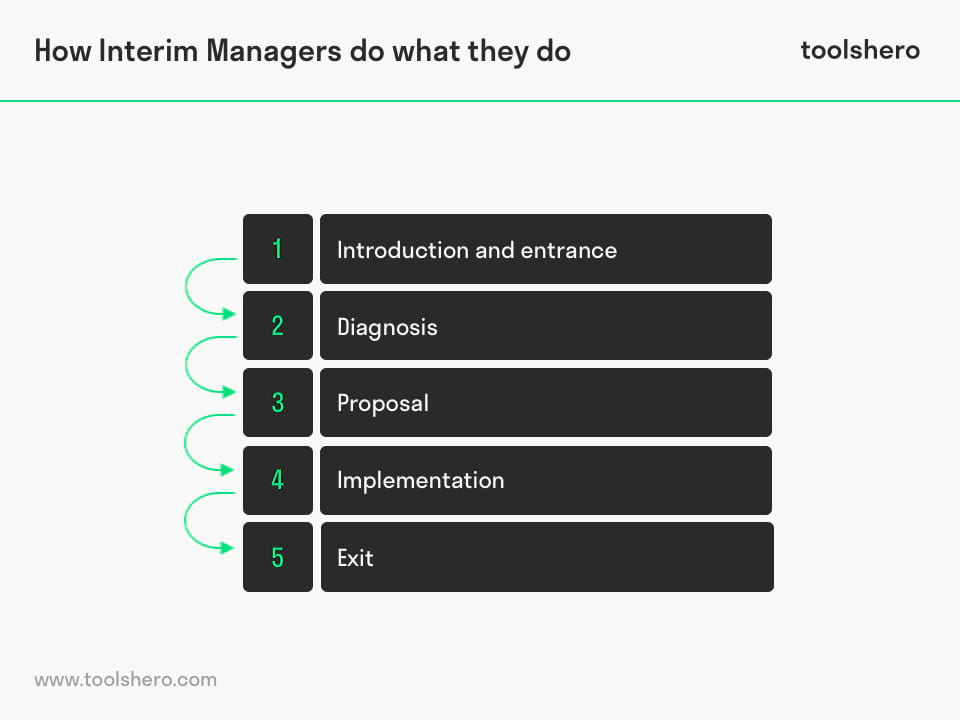Interim Management explained

Interim Management: this article provides a practical explanation of Interim Management. This article contains the definition and meaning of Interim Management, its added value, phases, the role of an interim manager and general tips. After reading, you will understand the basics of this management solution. Enjoy reading!
What is Interim Management?
The meaning of Interim Management
Interim Management (IM) refers to the temporary roles of people with management knowledge within an organisation. These roles can be full time or part time.
Interim managers are used because a permanent role isn’t necessary or because no person in the company is suitable or available for the job in question. An interim manager can offer stability to a company after an experienced leader has stepped down, for instance.
Modern IM started in about the 1970s. Employees in the Netherlands are protected by long notice periods and high costs for ending employment contracts. This made hiring temporary managers an obvious solution.
After that the concept made numerous appearances in studies into different forms of contractual relationships, for instance by Atkinson. Interim management is similar to Turnaround Management. IM is often seen as a tool in Crisis Management.
Practice
Interim managers are mainly used when organisations are undergoing changes. They are either self-employed, or work for an IM agency.
Sometimes a new role is created specifically for them by the senior management to make the target company more efficient. This role didn’t exist before they joined the company, but will usually become a permanent position.
When they first start the job, interim managers set a precedent about how their role should look. Companies will place their trust in the interim manager’s expertise to determine how the change is to be implemented.
Example of an Interim Management position
A family business that sells electronics is in a serious crisis after having lost significant market share in recent years, all resulting from an internal conflict. The CEO has stepped down, and the board can’t find a suitable leader with enough experience.
The board is faced with two options. The first is to try and recruit a senior executive search from another company. This is an expensive option for the short term, and might exacerbate the already tense situation in the family business.
The second option is to hire an experienced interim manager specialised in leadership and business structure optimisation.
With this option, there’s no expensive investment in a senior executive that could create further unrest. Instead an independent interim executive is hired who’s not part of the conflict.
The added value of Interim Management
There are different for the rise in popularity of Interim Management. Below we describe several reasons for why companies are increasingly opting for interim managers.
Expediency
Interim managers can start their interim assignments job within weeks or even days. This is essential because time is a critical factor for a business facing problems.
Knowledge
Interim managers are often overqualified for the job they will be doing. The skills and knowledge they bring are necessary to address a specific problem or close a knowledge gap. This experience and knowledge enables them to be productive from day one. One field where interim managers are used a lot is the sector of private equity.
Objectivity
Interim leaders are not involved with the internal corporate culture. They can communicate their vision unimpeded and are not under pressure to get their assignment extended as a management consultant would be.
Professionalism
Interim managers can be expected to go about their work very professionally. They don’t just take on an advisory role, but are actually responsible for the running of the company. Interim managers are often self-employed, so it helps their brand and strengthen their track record if an organisation improves. That’s not the case if an organisation hires an outside management consultant.
Interim Management: how Interim Managers do what they do

The Five Phases of Interim Management.
Temporary Interim Management assignments vary in duration, scope, and requirements. However, there are a number of phases that are typical for how interim managers carry out their work. The first stage starts with the interim executives acting as consultants. They prepare themselves for the implementation and change phases.
Phase 1: Introduction and entrance
When an organisation in trouble decides to get the help of an interim manager, the process starts.
The first thing a company does when contacting different interim managers is looking at which candidates are suitable for the challenge.
If they find the right candidate, the first phase officially starts with a couple of meetings, resulting in a preliminary hiring of the interim executive.
Phase 2: Diagnosis
The hired interim manager investigates the situation, the problem, and the organisation. He establishes how the situation evolved, who the stakeholders are, and other relevant aspects.
During this phase, they develop a more detailed understanding of what is going on. The diagnostic phase takes up to a week.
Phase 3: Proposal
After making the diagnosis, the interim manager starts working on a detailed proposal that includes objectives and milestones along the way.
The proposal is presented to the stakeholders by the board and management team, who then make a decision. If the proposal differs significantly from the vision held by the stakeholders, the interim manager will have to tweak it. Another option is for the company to go with a different expert.
Phase 4: Implementation
If they approve the proposal, the interim manager is given the green light to implement the changes. The interim manager manages the project, monitors progress, and regularly organises feedback and evaluation meetings with the company, their client.
Phase 5: Exit
When the interim project comes to an end, the objectives should have been met, and the client is hopefully satisfied. This phase is mostly about transferring knowledge and finding the right people to close knowledge and or skill gaps. It’s usually the end of the relationship between the company and the interim manager. Sometimes they continue to consult or stay on with the company for a follow-up assignment.
Interim Management summary
Interim managers are hired by organisations that are faced with a problem or shortage, be it in the form of knowledge, skills, structure, culture, etc. Interim management has been growing in popularity for a number of reasons.
These freelancing experts can be hired quickly and used in a position where their expertise is needed.
Interim managers are often overqualified professionals, whose extensive experience allows them to get going quickly and efficiently. They’re not a party to any conflicts and are objective and professional because the success of the project impacts their own reputation.
Hiring an interim manager starts with the client contacting potential interim managers. During this phase, the organisation assesses whether the interim manager meets its requirements.
If the expert is deemed suitable, the collaboration starts in the form of a preliminary meeting, after which they are given a temporary position at the company.
During the next phase, the project has a lot in common with the phases of project management. The interim manager comes up with a plan for changes or restructuring, which is then either approved or rejected.
Rejection means a new proposal, a change, or the end of the collaboration. Interim managers often continue to work for the company by either consulting or taking on a follow-up assignment.
Now It’s Your Turn
What do you think? Are you familiar with the explanation of interim management? Have you ever had an interim manager in your work environment? Did this happen on a senior level? Do you think you might have what it takes to become an interim manager? How do you think existing executives and employees in a company will react to an interim manager? Do you have any tips or additional comments?
Share your experience and knowledge in the comments box below.
More information
- Bruns, J., & Kabst, R. (2005). Interim-Management: A paradox for leadership research?. management revue, 512-524.
- McDOUGAL, R. A., Delano, E. O., Caplan, D., Sigurdsson, A., & Trope, M. (2004). Success of an alternative for interim management of irreversible pulpitis. The Journal of the American Dental Association, 135(12), 1707-1712.
- Smid, G., Van Hout, E., & Burger, Y. (2006). Leadership in organisational change: Rules for successful hiring in interim management. Journal of Change Management, 6(1), 35-51.
- Werther, W. B. (1998). Interim management of international strategic alliances. Management Decision, 36(5), 339-345.
How to cite this article:
Janse, B. (2019). Interim Management. Retrieved [insert date] from Toolshero: https://www.toolshero.com/management/interim-management/
Original publication date: 03/14/2018 | Last update: 04/17/2023
Add a link to this page on your website:
<a href=”https://www.toolshero.com/management/interim-management/”>Toolshero: Interim Management</a>












